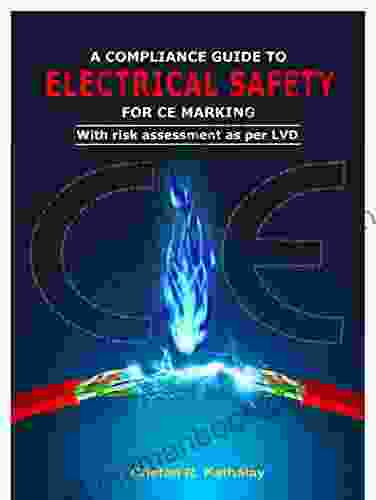Risk Assessment: A Comprehensive Guide to Enhancing Electrical Safety According to LVD Standards

Electrical safety is paramount in any industry or application that involves the use of electrical equipment. The Low Voltage Directive (LVD),implemented by the European Union, provides a comprehensive framework for manufacturers and designers to ensure the safety of electrical products. Risk assessment plays a vital role in this process, helping to identify and mitigate potential hazards associated with electrical equipment.
5 out of 5
| Language | : | English |
| File size | : | 5042 KB |
| Text-to-Speech | : | Enabled |
| Screen Reader | : | Supported |
| Print length | : | 67 pages |
| Lending | : | Enabled |
What is Risk Assessment?
Risk assessment is a systematic process of identifying, evaluating, and prioritizing potential hazards associated with a specific activity or product. In the context of electrical safety, risk assessment involves assessing the likelihood and severity of electrical hazards, and developing appropriate control measures to mitigate those risks.
Steps Involved in Risk Assessment
The process of risk assessment typically involves the following steps:
- Hazard Identification: This step involves identifying all potential hazards associated with the electrical equipment. This can be done by reviewing product specifications, conducting site inspections, and consulting with experts.
- Risk Analysis: This step involves evaluating the likelihood and severity of the identified hazards. The likelihood of a hazard occurring is typically rated as high, medium, or low. The severity of a hazard is typically rated as catastrophic, major, moderate, or minor.
- Risk Evaluation: This step involves comparing the likelihood and severity of each hazard to determine the overall risk level. The risk level is typically classified as high, medium, or low.
- Risk Control: This step involves developing and implementing control measures to mitigate the identified risks. Control measures can include engineering controls, administrative controls, and personal protective equipment.
- Risk Monitoring: This step involves monitoring the effectiveness of the implemented control measures and making any necessary adjustments to ensure continued safety.
Types of Hazards
Electrical hazards can be classified into several categories, including:
- Electrical Shock: This is the most common electrical hazard and can occur when a person comes into contact with a live electrical conductor.
- Electrical Burns: These can occur when a person comes into contact with a high-voltage electrical current.
- Arc Flash: This is a sudden release of energy that can occur when an electrical arc forms between two conductors.
- Electrical Fire: This can occur when electrical equipment overheats or malfunctions.
Benefits of Risk Assessment
Conducting a comprehensive risk assessment for electrical equipment offers several benefits, including:
- Enhanced Safety: Identifying and mitigating potential hazards helps prevent accidents and injuries.
- Compliance with Regulations: Risk assessment is a requirement under the LVD and other safety regulations.
- Improved Productivity: By reducing the risk of accidents and injuries, risk assessment can improve productivity and reduce downtime.
- Reduced Insurance Costs: A well-documented risk assessment can reduce insurance premiums.
Risk assessment is an essential element of electrical safety, helping to identify and mitigate potential hazards. By following the steps outlined in this article, organizations can create a safe and compliant workplace, reducing the risk of accidents and injuries.
Additional Resources
- Low Voltage Directive (LVD)
- Occupational Safety and Health Administration (OSHA) Electrical Safety
- International Electrotechnical Commission (IEC) Standards
5 out of 5
| Language | : | English |
| File size | : | 5042 KB |
| Text-to-Speech | : | Enabled |
| Screen Reader | : | Supported |
| Print length | : | 67 pages |
| Lending | : | Enabled |
Do you want to contribute by writing guest posts on this blog?
Please contact us and send us a resume of previous articles that you have written.
 Top Book
Top Book Novel
Novel Fiction
Fiction Nonfiction
Nonfiction Literature
Literature Paperback
Paperback Hardcover
Hardcover E-book
E-book Audiobook
Audiobook Bestseller
Bestseller Classic
Classic Mystery
Mystery Thriller
Thriller Romance
Romance Fantasy
Fantasy Science Fiction
Science Fiction Biography
Biography Memoir
Memoir Autobiography
Autobiography Poetry
Poetry Drama
Drama Historical Fiction
Historical Fiction Self-help
Self-help Young Adult
Young Adult Childrens Books
Childrens Books Graphic Novel
Graphic Novel Anthology
Anthology Series
Series Encyclopedia
Encyclopedia Reference
Reference Guidebook
Guidebook Textbook
Textbook Workbook
Workbook Journal
Journal Diary
Diary Manuscript
Manuscript Folio
Folio Pulp Fiction
Pulp Fiction Short Stories
Short Stories Fairy Tales
Fairy Tales Fables
Fables Mythology
Mythology Philosophy
Philosophy Religion
Religion Spirituality
Spirituality Essays
Essays Critique
Critique Commentary
Commentary Glossary
Glossary Bibliography
Bibliography Index
Index Table of Contents
Table of Contents Preface
Preface Introduction
Introduction Foreword
Foreword Afterword
Afterword Appendices
Appendices Annotations
Annotations Footnotes
Footnotes Epilogue
Epilogue Prologue
Prologue Handugs Smithson
Handugs Smithson Rosemary Dobson
Rosemary Dobson Ian Stables
Ian Stables Mirella Colalillo
Mirella Colalillo Tarin Lex
Tarin Lex Harriet De Winton
Harriet De Winton Phoenix
Phoenix Christian Shields
Christian Shields William I Woodson
William I Woodson Markus Heitkoetter
Markus Heitkoetter Christina Hoag
Christina Hoag Ted Tayler
Ted Tayler Chrissy Sisco
Chrissy Sisco Gerald Everett Jones
Gerald Everett Jones Douglas Dales
Douglas Dales John H Carroll
John H Carroll Gigi M Green
Gigi M Green Dr W Ness
Dr W Ness Ron Padgett
Ron Padgett Erika Lee
Erika Lee
Light bulbAdvertise smarter! Our strategic ad space ensures maximum exposure. Reserve your spot today!
 Clark CampbellFollow ·2.2k
Clark CampbellFollow ·2.2k Alan TurnerFollow ·3.5k
Alan TurnerFollow ·3.5k Cade SimmonsFollow ·8.2k
Cade SimmonsFollow ·8.2k Philip BellFollow ·19.7k
Philip BellFollow ·19.7k Edwin BlairFollow ·6.8k
Edwin BlairFollow ·6.8k Derek CookFollow ·2k
Derek CookFollow ·2k Jace MitchellFollow ·14.4k
Jace MitchellFollow ·14.4k F. Scott FitzgeraldFollow ·9.7k
F. Scott FitzgeraldFollow ·9.7k

 Preston Simmons
Preston SimmonsThe Ultimate Manual for Men: A Guide to Living a...
Being a man in today's world can be...

 José Martí
José MartíLessons From 30 Years of Outperforming Investment...
The stock market is a complex and...

 Leo Mitchell
Leo MitchellChildren of Great Musicians: An Illustrated Collection
Music has the power to move us,...

 Jackson Hayes
Jackson HayesGet Room Quirky Lustful Poetry
Poetry is a form of...

 Rex Hayes
Rex HayesComprehensive Guide For Advisers Practitioners And...
The Heilbrunn Center is a mental health...
5 out of 5
| Language | : | English |
| File size | : | 5042 KB |
| Text-to-Speech | : | Enabled |
| Screen Reader | : | Supported |
| Print length | : | 67 pages |
| Lending | : | Enabled |














